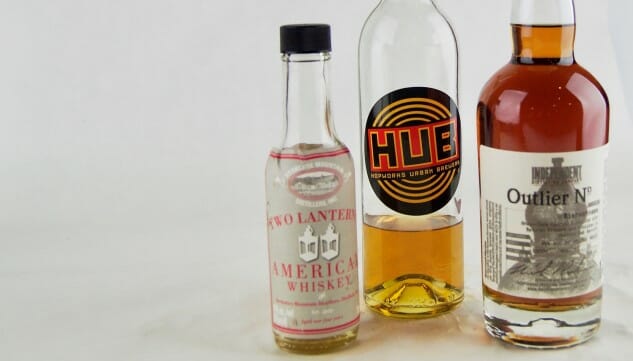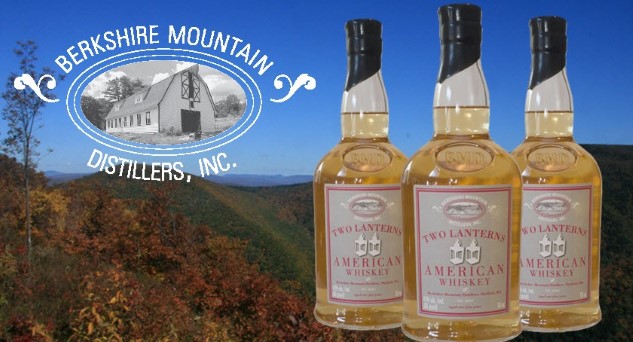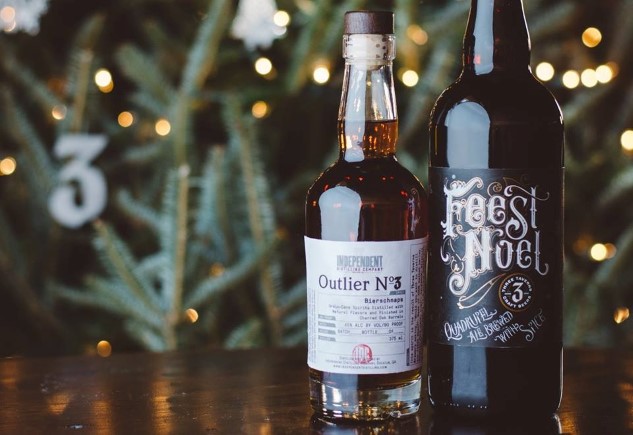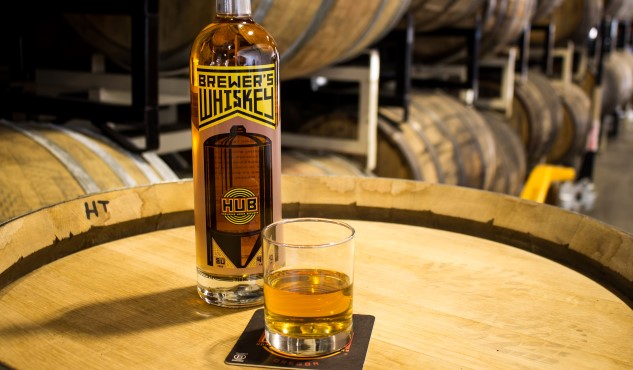Tasting 3 Whiskeys Distilled From Craft Beers
Photos by Annie Black Drink Features Distilled Craft Beer
As recently as two months ago, I’d never even considered the idea of a whiskey distilled from a beer. Now, just a short while later, I’ve tasted a small handful of them, and am ready to report back. The findings are positive: This is a truly fascinating intersection between the world of craft beer and microdistilling. There’s room here for an entirely new field of liquor: Distilled beers! How has this not already become common? The collaboration seems so obvious in hindsight, right? In some states such as Alabama, breweries are even allowed to own and operate their own distilleries as well, meaning the entire process could be conducted under one company’s banner.
As it turns out, this isn’t a completely new field. Although some breweries/distilleries have taken these distilled beers and referred to them as whiskey (this being a distilled malt product by definition), others have given the product its own name: “Bierschnapps.” I honestly have no idea which is more proper to use, so I’m simply going to call them “distilled beer” or whiskey.
Last week, after acquiring a few new distilled beers, I contacted one of the local distilleries just down the street from Paste who I’d learned was also producing whiskeys distilled from products of local breweries. Joined by a representative of Decatur, GA’s Independent Distilling Co., we conducted a mini-tasting of three vastly different whiskeys distilled from three very different beers. It was a clear illustration of the variety and promise these products hold, and how distinctly different they can be from traditional American whiskey.
New Deal Distillery/Hopworks Urban Brewery – HUB Brewer’s Whiskey
Of the three liquors we tasted, this new example from Portland, OR’s Hopworks would no doubt be the most familiar to American whiskey drinkers. It’s the only one of the three produced from a beer (in this case, HUB Organic Lager) that was completely unhopped, presumably to avoid any hop-derived bitterness in the final product. That beer was distilled and then aged in “a variety of American oak barrels,” but it’s clear from the profile that at least some of them were newly charred white oak, as is typical in bourbon and rye.
The result is a mild, sweet, grainy and approachable whiskey that doesn’t seem terribly different from a classic 80 proof bourbon in the vein of Jim Beam White Label, despite the fact that it’s coming from a 100% malted barley beer, rather than a bourbon mash bill of at least 51% corn. Honeyed sweetness is the dominant impression, with a hint of maple/custard. It’s a bit smoother and rounder than most bourbons of the same weight class, lacking the spice/fruitier notes of rye as a flavoring grain, but with no shortage of barrel character. I’m actually impressed that it seems more like a bourbon than it does an Irish whiskey, given the mash bill—this tells me that they managed to draw a pretty good amount of caramel/vanillans out of their barrels. With a fairly low, gentle level of alcoholic heat, HUB Brewer’s Whiskey drinks quite easily. It seems perfect as an “introductory whiskey” for those who don’t necessarily love the character of American bourbon, but perhaps enjoy Irish whiskeys such as Jameson. You could think of it as a bit of a bridge between the two; very easy to drink neat. In fact, I wouldn’t recommend trying to mix this whiskey, as its delicate nature would likely be lost when combined with mixers or cocktail ingredients.
Berkshire Mountain Distillers/Samuel Adams – Two Lanterns American Whiskey

Receiving this whiskey in the mail kicked off my entire fascination with the concept of distilled beers, at least partially because this one comes from an American classic: Samuel Adams Boston Lager. That’s right—Two Lanterns is just straight-up, good old Boston Lager, distilled and then barrel-aged. How cool is that? A beer that every drinker in the country has been familiar with for years or decades, and you find a way to make it exciting and interesting again. I love this new trend!
Unlike the HUB Brewer’s Whiskey, Two Lanterns is made from a complete, hopped beer—the same Boston Lager you’d find in stores. The press release notes that it’s been aged in “vintage bourbon barrels,” which is presumably distillery-ese for “used bourbon barrels,” unlike the newly charred American oak that Hopworks was using. Thus, this whiskey’s four years of aging have more in common with scotch or Irish whiskey, which are aged in used American whiskey barrels. As a result, the finished product draws significantly less color out of the wood, and correspondingly less barrel character than the HUB whiskey. Instead, its profile is much more influenced by the distilled base beer rather than the barrel it was aged in. We’re also given a clue at the economies of scale involved here—the press release states that a whopping 25,000 gallons of Boston Lager was needed to make 1,000 gallons of triple-distilled Two Lanterns. That is quite the conversion rate.
The end result is decidedly unique—it could hardly be more different from the HUB whiskey. On the nose, you’re hit with a big wave of woodsy, spicy pineyness; slightly car freshener-esque, but not unpleasant. It smells significantly hotter and wilder than the easygoing HUB whiskey, and this is revealed as truth on the palate. Decidedly less sweet, its profile is complex and bracing—pine sap, exotic spice and honey. On some level, you’d almost compare it with an American gin that is heavy on the pine-like botanicals, such as St. George Terroir, except that it’s fuller of body and has more residual sweetness. Some tasters found these woody flavors (presumably hop-derived) to be too much, or difficult to drink, but I actually find them enjoyably unique. Bitterness is stronger here, to the point where I don’t expect we’ll be seeing any distilled IPAs any time soon, but it makes for an unusual, sophisticated dram. Perhaps it’s fair to simply say that Two Lanterns is a bit more ambitious, or more of an acquired taste, but I think there’s a subset of whiskey drinkers out there who would love this.
Independent Distilling Co./Three Taverns Brewery – Outlier #3

We come now to the most unusual and ultimately rewarding of the three whiskeys we sampled, from two companies that operate within a few hundred feet of each other—Independent Distilling Co. and Three Taverns Brewery. What makes this particular product so different is the choice of beer style—not a light-bodied lager, but a freaking Belgian quadruple/Belgian Christmas ale called Feest Noel. That is a massively different type of beer to attempt in distillation, and it’s still hard for me to believe that it all comes together so well in the end.
Honestly, I wouldn’t have thought that one could even distill a huge, boozy, rich, spice-laden beer style such as Belgian quad. And even if you could, how would a high-gravity, fruity and spiced flavor profile translate to a liquor? It’s completely uncharted territory.
Turns out, I needn’t have worried, because the results are rather wonderful. The nose is redolent in spices, in a way completely different from any American whiskey or rye I’ve ever encountered—even the ones I’ve described as having “baking spice” aromatics. This whiskey, or “bierschnapps,” features strong notes of cardamom, berry, allspice and something like the piney-ness of juniper on its nose. They come together to form something that reminds me of the spice profile of a really good cola or root beer, which is interesting, given that I’ve always found the barrel-aged version of Feest Noel to manifest a similar “cola” characteristic on the nose.
On the palate, this stuff is wonderfully complex and distinctive. Brown sugar, molasses, vanilla and that same blend of cardamom-led spice present themselves in a flavor profile that seems almost like a pre-made cocktail of some kind. It’s not nearly as sweet as I would have expected, given how rich the base beer is, which really does help it seem more like an American whiskey than some sort of liqueur. Impressively, despite this one being 90 proof, the booze is quite soft and comparable with the HUB offering, making it also more purely drinkable than I would have expected.
All in all, I’m blown away by this stuff. The mixology potential alone is massive—it’s very enjoyable on its own, but I imagine that bartenders would salivate at all the new cocktails they could base around such a peculiarly spiced spirit. I sincerely hope that we see more of these whiskeys/bierschnapps on the market, and in greater quantities. Rarely has an experiment gone so right.
Jim Vorel is Paste’s resident craft beer and whiskey guru. You can follow him on Twitter for much more drinks content.
